engine PONTIAC G6 2006 Owner's Manual
[x] Cancel search | Manufacturer: PONTIAC, Model Year: 2006, Model line: G6, Model: PONTIAC G6 2006Pages: 416, PDF Size: 2.66 MB
Page 113 of 416

Use the following procedure to shift into PARK (P):
1. Hold the brake pedal down with your right foot and
set the parking brake.
2. Move the shift lever into PARK (P) by holding in the
button on the shift lever and pushing the lever all
the way toward the front of the vehicle.
3. Turn the ignition key to OFF.
4. Remove the key and take it with you. If you can
leave your vehicle with the ignition key in your
hand, your vehicle is in PARK (P).Leaving Your Vehicle With the Engine
Running (Automatic Transaxle)
{CAUTION:
It can be dangerous to leave your vehicle with
the engine running. Your vehicle could move
suddenly if the shift lever is not fully in
PARK (P) with the parking brake �rmly set.
And, if you leave the vehicle with the engine
running, it could overheat and even catch �re.
You or others could be injured. Do not leave
your vehicle with the engine running.
If you have to leave your automatic transaxle vehicle
with the engine running, be sure your vehicle is in
PARK (P) and your parking brake is �rmly set before
you leave it. After you have moved the shift lever
into PARK (P), hold the regular brake pedal down. Then,
see if you can move the shift lever away from PARK (P)
without �rst pushing the button.
If you can, it means that the shift lever was not fully
locked into PARK (P).
2-35
Page 115 of 416

Parking Over Things That Burn
{CAUTION:
Things that can burn could touch hot exhaust
parts under your vehicle and ignite. Do not
park over papers, leaves, dry grass or other
things that can burn.
Engine Exhaust
{CAUTION:
Engine exhaust can kill. It contains the gas
carbon monoxide (CO), which you cannot see or
smell. It can cause unconsciousness and death.
You might have exhaust coming in if:
Your exhaust system sounds strange or
different.
Your vehicle gets rusty underneath.
Your vehicle was damaged in a collision.
Your vehicle was damaged when driving
over high points on the road or over road
debris.
Repairs were not done correctly.
Your vehicle or exhaust system had been
modi�ed improperly.
If you ever suspect exhaust is coming into your
vehicle:
Drive it only with all the windows down to
blow out any CO; and
Have your vehicle �xed immediately.
2-37
Page 116 of 416
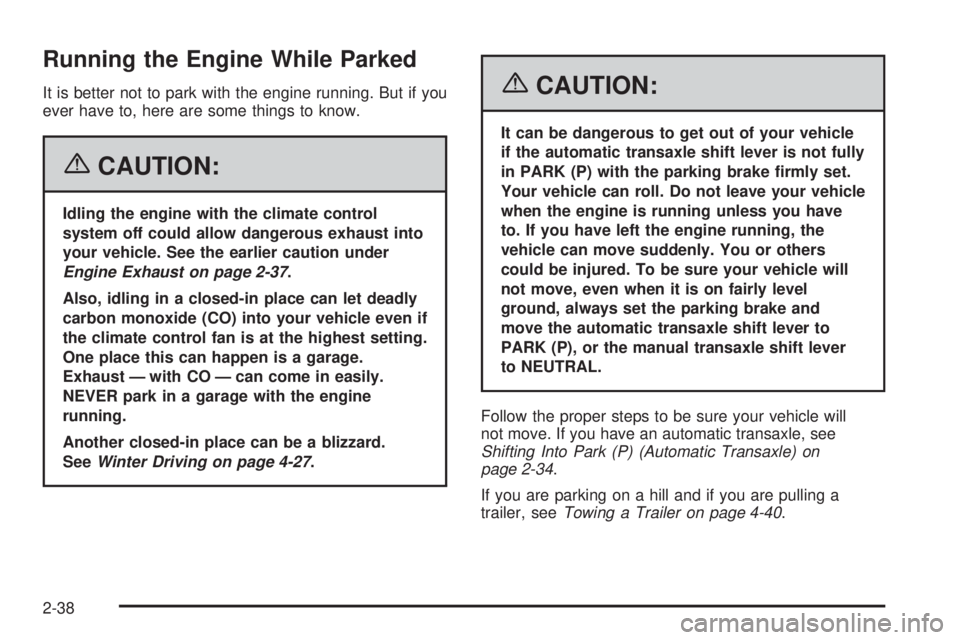
Running the Engine While Parked
It is better not to park with the engine running. But if you
ever have to, here are some things to know.
{CAUTION:
Idling the engine with the climate control
system off could allow dangerous exhaust into
your vehicle. See the earlier caution under
Engine Exhaust on page 2-37.
Also, idling in a closed-in place can let deadly
carbon monoxide (CO) into your vehicle even if
the climate control fan is at the highest setting.
One place this can happen is a garage.
Exhaust — with CO — can come in easily.
NEVER park in a garage with the engine
running.
Another closed-in place can be a blizzard.
SeeWinter Driving on page 4-27.
{CAUTION:
It can be dangerous to get out of your vehicle
if the automatic transaxle shift lever is not fully
in PARK (P) with the parking brake �rmly set.
Your vehicle can roll. Do not leave your vehicle
when the engine is running unless you have
to. If you have left the engine running, the
vehicle can move suddenly. You or others
could be injured. To be sure your vehicle will
not move, even when it is on fairly level
ground, always set the parking brake and
move the automatic transaxle shift lever to
PARK (P), or the manual transaxle shift lever
to NEUTRAL.
Follow the proper steps to be sure your vehicle will
not move. If you have an automatic transaxle, see
Shifting Into Park (P) (Automatic Transaxle) on
page 2-34.
If you are parking on a hill and if you are pulling a
trailer, seeTowing a Trailer on page 4-40.
2-38
Page 127 of 416

Retractable Hardtop
The following procedures explain the proper operation
of the retractable hardtop. The retractable hardtop
will not operate if the trunk cargo cover is not in place.
If the retractable hardtop is lowered or raised multiple
times, the engine should be running while doing
so to prevent drain on the vehicle’s battery.
{CAUTION:
Moving parts of the retractable hardtop can
be dangerous. People can be injured by the
hardtop and its mechanism. Keep people away
from your vehicle when you are lowering or
raising the top.
Lowering the Retractable Hardtop
Notice:Leaving the retractable hardtop down and
exposing the interior of your vehicle to outdoor
conditions may cause damage. Always close
the retractable hardtop if leaving your vehicle
outdoors.
Notice:Raising or lowering the top while the
vehicle is in motion can cause damage to the top
or top mechanism. Make sure the vehicle is in
PARK (P) to lower or raise the top.
Notice:Lowering the top if it is damp, wet, or
dirty can cause stains, mildew, and damage to
the inside of your vehicle. Dry off the top before
lowering it.
2-49
Page 128 of 416
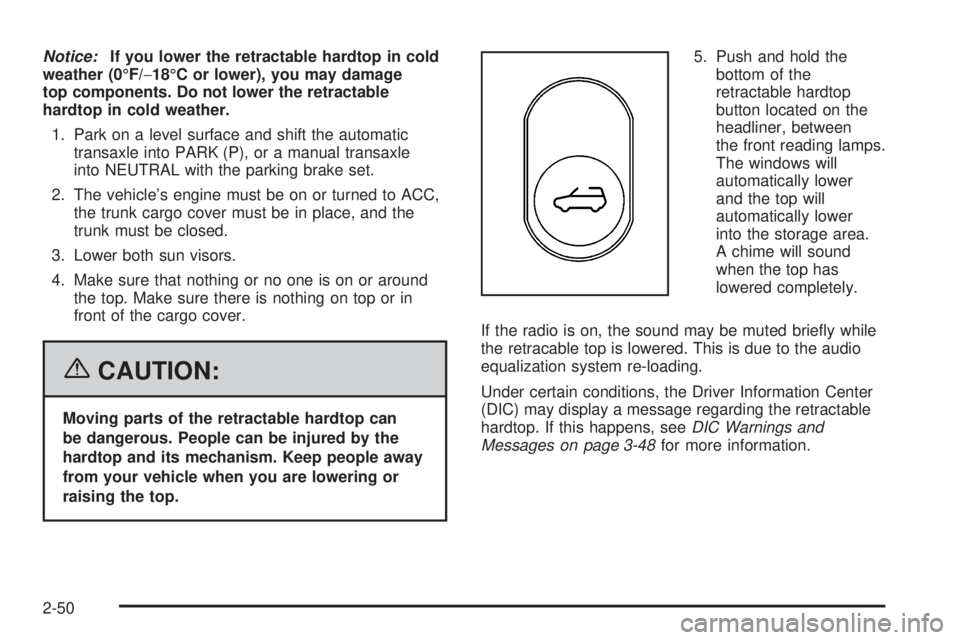
Notice:If you lower the retractable hardtop in cold
weather (0°F/−18°C or lower), you may damage
top components. Do not lower the retractable
hardtop in cold weather.
1. Park on a level surface and shift the automatic
transaxle into PARK (P), or a manual transaxle
into NEUTRAL with the parking brake set.
2. The vehicle’s engine must be on or turned to ACC,
the trunk cargo cover must be in place, and the
trunk must be closed.
3. Lower both sun visors.
4. Make sure that nothing or no one is on or around
the top. Make sure there is nothing on top or in
front of the cargo cover.
{CAUTION:
Moving parts of the retractable hardtop can
be dangerous. People can be injured by the
hardtop and its mechanism. Keep people away
from your vehicle when you are lowering or
raising the top.5. Push and hold the
bottom of the
retractable hardtop
button located on the
headliner, between
the front reading lamps.
The windows will
automatically lower
and the top will
automatically lower
into the storage area.
A chime will sound
when the top has
lowered completely.
If the radio is on, the sound may be muted brie�y while
the retracable top is lowered. This is due to the audio
equalization system re-loading.
Under certain conditions, the Driver Information Center
(DIC) may display a message regarding the retractable
hardtop. If this happens, seeDIC Warnings and
Messages on page 3-48for more information.
2-50
Page 129 of 416
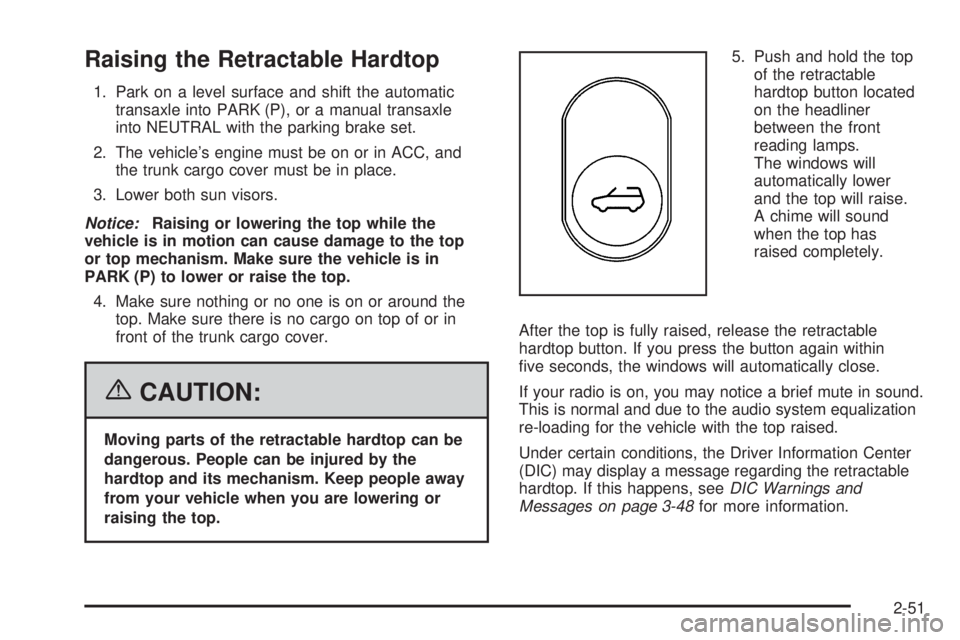
Raising the Retractable Hardtop
1. Park on a level surface and shift the automatic
transaxle into PARK (P), or a manual transaxle
into NEUTRAL with the parking brake set.
2. The vehicle’s engine must be on or in ACC, and
the trunk cargo cover must be in place.
3. Lower both sun visors.
Notice:Raising or lowering the top while the
vehicle is in motion can cause damage to the top
or top mechanism. Make sure the vehicle is in
PARK (P) to lower or raise the top.
4. Make sure nothing or no one is on or around the
top. Make sure there is no cargo on top of or in
front of the trunk cargo cover.
{CAUTION:
Moving parts of the retractable hardtop can be
dangerous. People can be injured by the
hardtop and its mechanism. Keep people away
from your vehicle when you are lowering or
raising the top.5. Push and hold the top
of the retractable
hardtop button located
on the headliner
between the front
reading lamps.
The windows will
automatically lower
and the top will raise.
A chime will sound
when the top has
raised completely.
After the top is fully raised, release the retractable
hardtop button. If you press the button again within
�ve seconds, the windows will automatically close.
If your radio is on, you may notice a brief mute in sound.
This is normal and due to the audio system equalization
re-loading for the vehicle with the top raised.
Under certain conditions, the Driver Information Center
(DIC) may display a message regarding the retractable
hardtop. If this happens, seeDIC Warnings and
Messages on page 3-48for more information.
2-51
Page 131 of 416
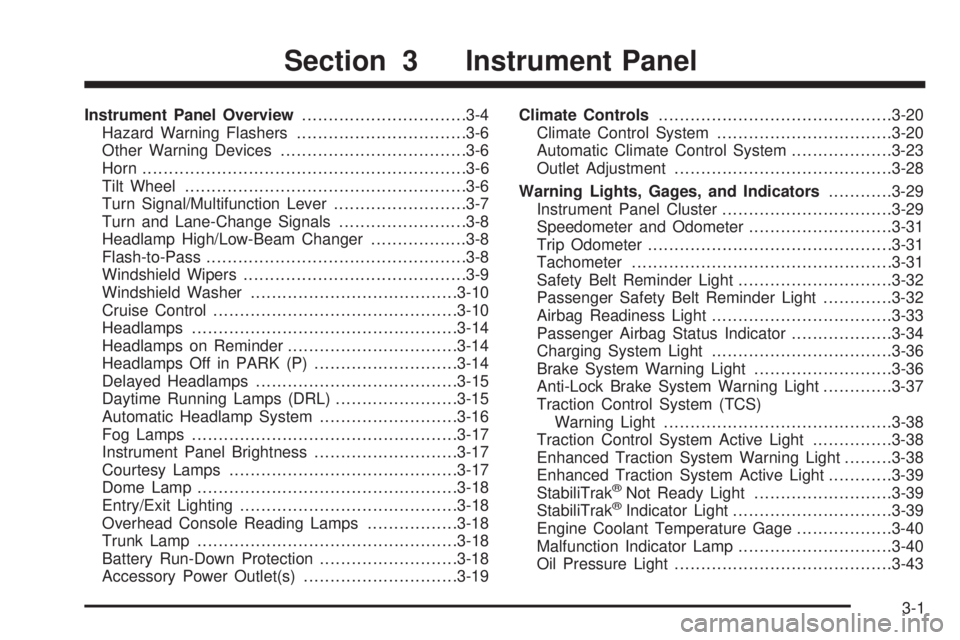
Instrument Panel Overview...............................3-4
Hazard Warning Flashers................................3-6
Other Warning Devices...................................3-6
Horn.............................................................3-6
Tilt Wheel.....................................................3-6
Turn Signal/Multifunction Lever.........................3-7
Turn and Lane-Change Signals........................3-8
Headlamp High/Low-Beam Changer..................3-8
Flash-to-Pass.................................................3-8
Windshield Wipers..........................................3-9
Windshield Washer.......................................3-10
Cruise Control..............................................3-10
Headlamps..................................................3-14
Headlamps on Reminder................................3-14
Headlamps Off in PARK (P)...........................3-14
Delayed Headlamps......................................3-15
Daytime Running Lamps (DRL).......................3-15
Automatic Headlamp System..........................3-16
Fog Lamps..................................................3-17
Instrument Panel Brightness...........................3-17
Courtesy Lamps...........................................3-17
Dome Lamp.................................................3-18
Entry/Exit Lighting.........................................3-18
Overhead Console Reading Lamps.................3-18
Trunk Lamp.................................................3-18
Battery Run-Down Protection..........................3-18
Accessory Power Outlet(s).............................3-19Climate Controls............................................3-20
Climate Control System.................................3-20
Automatic Climate Control System...................3-23
Outlet Adjustment.........................................3-28
Warning Lights, Gages, and Indicators............3-29
Instrument Panel Cluster................................3-29
Speedometer and Odometer...........................3-31
Trip Odometer..............................................3-31
Tachometer.................................................3-31
Safety Belt Reminder Light.............................3-32
Passenger Safety Belt Reminder Light.............3-32
Airbag Readiness Light..................................3-33
Passenger Airbag Status Indicator...................3-34
Charging System Light..................................3-36
Brake System Warning Light..........................3-36
Anti-Lock Brake System Warning Light.............3-37
Traction Control System (TCS)
Warning Light...........................................3-38
Traction Control System Active Light...............3-38
Enhanced Traction System Warning Light.........3-38
Enhanced Traction System Active Light............3-39
StabiliTrak
®Not Ready Light..........................3-39
StabiliTrak®Indicator Light..............................3-39
Engine Coolant Temperature Gage..................3-40
Malfunction Indicator Lamp.............................3-40
Oil Pressure Light.........................................3-43
Section 3 Instrument Panel
3-1
Page 151 of 416
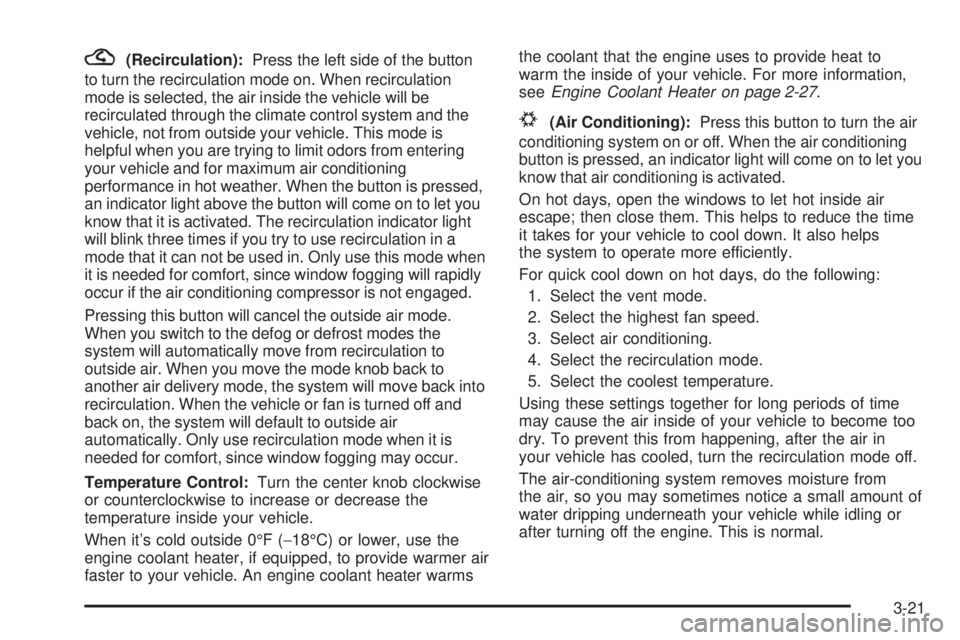
?(Recirculation):Press the left side of the button
to turn the recirculation mode on. When recirculation
mode is selected, the air inside the vehicle will be
recirculated through the climate control system and the
vehicle, not from outside your vehicle. This mode is
helpful when you are trying to limit odors from entering
your vehicle and for maximum air conditioning
performance in hot weather. When the button is pressed,
an indicator light above the button will come on to let you
know that it is activated. The recirculation indicator light
will blink three times if you try to use recirculation in a
mode that it can not be used in. Only use this mode when
it is needed for comfort, since window fogging will rapidly
occur if the air conditioning compressor is not engaged.
Pressing this button will cancel the outside air mode.
When you switch to the defog or defrost modes the
system will automatically move from recirculation to
outside air. When you move the mode knob back to
another air delivery mode, the system will move back into
recirculation. When the vehicle or fan is turned off and
back on, the system will default to outside air
automatically. Only use recirculation mode when it is
needed for comfort, since window fogging may occur.
Temperature Control:Turn the center knob clockwise
or counterclockwise to increase or decrease the
temperature inside your vehicle.
When it’s cold outside 0°F (−18°C) or lower, use the
engine coolant heater, if equipped, to provide warmer air
faster to your vehicle. An engine coolant heater warmsthe coolant that the engine uses to provide heat to
warm the inside of your vehicle. For more information,
seeEngine Coolant Heater on page 2-27.
#(Air Conditioning):Press this button to turn the air
conditioning system on or off. When the air conditioning
button is pressed, an indicator light will come on to let you
know that air conditioning is activated.
On hot days, open the windows to let hot inside air
escape; then close them. This helps to reduce the time
it takes for your vehicle to cool down. It also helps
the system to operate more efficiently.
For quick cool down on hot days, do the following:
1. Select the vent mode.
2. Select the highest fan speed.
3. Select air conditioning.
4. Select the recirculation mode.
5. Select the coolest temperature.
Using these settings together for long periods of time
may cause the air inside of your vehicle to become too
dry. To prevent this from happening, after the air in
your vehicle has cooled, turn the recirculation mode off.
The air-conditioning system removes moisture from
the air, so you may sometimes notice a small amount of
water dripping underneath your vehicle while idling or
after turning off the engine. This is normal.
3-21
Page 153 of 416

Rear Window Defogger
The rear window defogger uses a warming grid to
remove fog or frost from the rear window.
to let you know that the rear window defogger is
activated. Be sure to clear as much snow from the rear
window as possible.
If driving below 50 mph (80 km/h), the rear window
defogger will turn off about 15 minutes after the button
is pressed. If turned on again, the defogger will only
run for about seven minutes before turning off. The
defogger can also be turned off by pressing the button
again or by turning off the engine.
If your vehicle’s speed is maintained above 50 mph
(80 km/h), the rear window defogger will remain on once
the button is pressed.
If your vehicle has the remote start feature, the rear
defogger will automatically be turned on if it is cold
outside. The indicator light will be on. When the vehicle
transitions out of the remote start mode, the rear
defogger will turn off.
Notice:Do not use anything sharp on the inside of
the rear window. If you do, you could cut or
damage the warming grid, and the repairs would not
be covered by your warranty. Do not attach a
temporary vehicle license, tape, a decal or anything
similar to the defogger grid.
Automatic Climate Control System
If your vehicle has this system, you can automatically
control the heating, cooling and ventilation in your
vehicle.
Automatic Operation
AUTO (Automatic):Select AUTO on both the fan
speed control and the air delivery mode control knobs to
activate the automatic system. When automatic
operation is active the system will control the inside
temperature and air delivery.
3-23
Page 154 of 416

Use the steps below to place the entire system in
automatic mode:
1. Place the fan knob and the mode knob to AUTO.
The display will now show the current set
temperature. When auto is selected, the air
conditioning operation and air inlet will be
automatically controlled. The air conditioning
compressor will run when the outside temperature
is over about 40°F (4°C). The air inlet will normally
be set to outside air. If it’s hot outside, the air
inlet may automatically switch to recirculate inside
air to help quickly cool down your vehicle.
2. Set the temperature.
To �nd your comfort setting, start with an initial
temperature setting and allow about 20 minutes for
the system to regulate. Press the up or down
arrow temperature buttons to adjust the temperature
setting as necessary. If you choose the temperature
setting of 60°F (15°C) the system will remain at
the maximum cooling setting. If you choosethe temperature setting of 90°F (32°C) the system
will remain at the maximum heat setting. Choosing
either maximum setting will not cause the vehicle
to heat or cool any faster.
Be careful not to cover the sensor located on the
top of the instrument panel near the windshield. This
sensor regulates air temperature based on sun
load, and also turns on your headlamps.
Also be careful not to cover the sensor grille on the
lower right side of the climate control faceplate.
This senses the inside vehicle temperature needed
for proper regulation.
To avoid blowing cold air at start-up in cold weather,
the system will delay turning on the fan until
warm air is available. The length of delay depends
on the engine coolant temperature. Turning the
fan knob will override this delay and change the fan
to a selected speed.
3-24